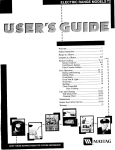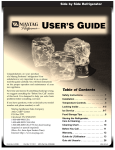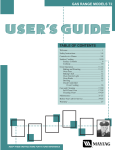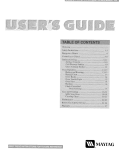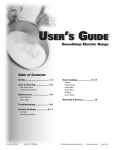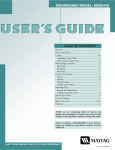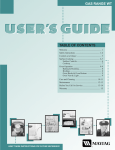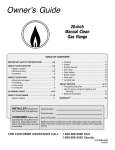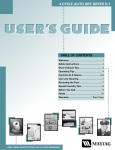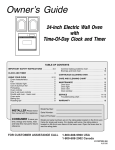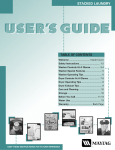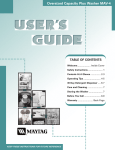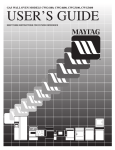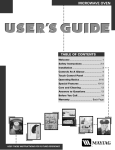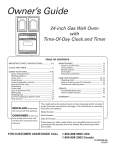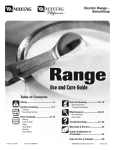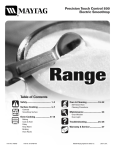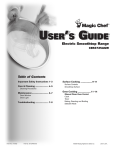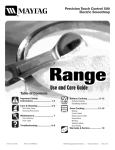Download Maytag MES5770 User`s guide
Transcript
○ ○ ○ ○ ○ ○ ○ ○ ○ ○ ○ ○ ○ ○ ○ ○ ○ ○ ○ ○ ○ ○ ○ ○ ○ ○ ○ ○ ELECTRIC RANGE MODELS T2 TABLE OF CONTENTS ○ ○ ○ ○ ○ ○ ○ ○ ○ ○ ○ ○ ○ ○ ○ ○ ○ ○ ○ ○ ○ ○ ○ ○ ○ ○ ○ ○ ○ ○ ○ ○ ○ ○ ○ ○ ○ ○ ○ ○ ○ ○ ○ ○ ○ ○ ○ ○ ○ ○ ○ ○ ○ ○ ○ ○ ○ ○ ○ ○ ○ Welcome ................................................................. 1 Safety Instructions ............................................... 1-3 Range at a Glance ................................................... 4 Controls at a Glance ............................................ 5-8○ Surface Cooking ................................................ 8-11 Surface Controls ............................................ 8-9 Coil Element Surface ..................................... 10 Glass-Ceramic Surface ................................... 11 Oven Operation ................................................ 12-17 Baking and Roasting ................................. 12-13 Baking Chart .................................................. 13 Oven Racks .................................................... 14 Oven Vent & Light ......................................... 15 Oven Fans ...................................................... 15 Broiling .......................................................... 16 Clock Controlled Oven Cooking .......................................... 17 Care and Cleaning ........................................... 18-21 Self-Clean Oven ........................................ 18-19 Cleaning Chart .......................................... 20-21 Maintenance .................................................... 22-23 Before You Call for Service ............................. 24-26 Warranty ............................................................... 27 ○ ○ ○ ○ ○ ○ ○ ○ ○ ○ ○ ○ ○ ○ ○ ○ ○ ○ ○ ○ ○ ○ ○ ○ ○ ○ ○ ○ ○ ○ ○ ○ ○ ○ ○ ○ ○ ○ ○ ○ ○ ○ ○ ○ ○ ○ ○ ○ ○ ○ ○ ○ ○ ○ ○ ○ ○ ○ ○ ○ ○ KEEP THESE INSTRUCTIONS FOR FUTURE REFERENCE ® Model: • MER5870, MEP5770, MES5570, MES5770, MES5870 Welcome IMPORTANT SAFETY INSTRUCTIONS ○ ○ ○ ○ ○ ○ ○ ○ ○ ○ ○ ○ ○ ○ ○ ○ ○ ○ ○ ○ ○ ○ ○ ○ ○ ○ ○ ○ ○ ○ Congratulations on your choice of a Maytag electric range. Your complete satisfaction is very important to us. Read and follow all instructions before using this appliance to prevent the potential risk of fire, electric shock, personal injury or damage to the appliance as a result of improper usage of the appliance. Use appliance only for its intended purpose as described in this guide. Read this user’s guide carefully. It is intended to help you operate and maintain your new range. In addition, you will find a booklet entitled “Cooking Made Simple.” It contains information on selecting cookware and provides baking, roasting and broiling tips. To ensure proper and safe operation: Appliance must be properly installed and grounded by a qualified technician. Save time and money. Check the “Before You Call” section of this guide. It lists causes of minor operating problems that you can correct yourself. However, should you need service, it is helpful to have the model and serial numbers available. This information can be found on the data plate located on the storage drawer frame or under the control panel. WARNING • These numbers are also on the Product Registration card that came with your appliance. Before sending in this card, record these numbers along with the purchase date below. • • ALL RANGES CAN TIP AND CAUSE INJURIES TO PERSONS INSTALL ANTI-TIP DEVICE PACKED WITH RANGE FOLLOW ALL INSTALLATION INSTRUCTIONS Model Number –– –– –– –– –– –– –– –– –– –– WARNING: To reduce risk of tipping of the appliance from abnormal usage or by excessive loading of the oven door, the appliance must be secure by a properly installed anti-tip device. Serial Number –– –– –– –– –– –– –– –– –– –– Date of Purchase To check if device is properly installed, remove storage drawer and look underneath range to make sure one of the rear leveling legs is properly engaged in the bracket slot. The anti-tip device secures the rear leveling leg to the floor when properly engaged. You should check this anytime the range has been moved. _______________________________ IMPORTANT: Keep this guide and the sales receipt in a safe place for future reference. Proof of original purchase date is needed for warranty service. If you have questions, write us (include your model number and phone number) or call: Maytag Appliances Sales Company Attn: CAIRSM Center P.O. Box 2370 Cleveland, TN 37320-2370 1-800-688-9900 (USA) 1-800-688-2002 (CANADA) 1-800-688-2080 ( U.S. TTY for deaf, hearing impaired or speech impaired) (Mon. - Fri., 8 am-8 pm Eastern Time) Internet: http://www.maytag.com In Case of Fire Turn off appliance and ventilating hood to avoid spreading the flame. Extinguish flame then turn on hood to remove smoke and odor. • Cooktop: Smother fire or flame in a pan with a lid or cookie sheet. NEVER pick up or move a flaming pan. • Oven: Smother fire or flame by closing the oven door. For service information, see page 26. NOTE: In our continuing effort to improve the quality and performance of our cooking products, it may be necessary to make changes to the appliance without revising this guide. Do not use water on grease fires. Use baking soda, a dry chemical or foam-type extinguisher to smother fire or flame. 1 General Instructions This appliance is equipped with different size surface elements. Select pans having flat bottoms large enough to cover element. Proper relationship of pan to element will improve cooking efficiency. WARNING: NEVER use appliance door, or drawer, if equipped, as a step stool or seat as this may result in possible tipping of the appliance, damage to the appliance, and serious injuries. If pan is smaller than element, a portion of the element will be exposed to direct contact and could ignite clothing or potholder. If appliance is installed near a window, proper precautions should be taken to prevent curtains from blowing over surface elements. Only certain types of glass, glass/ceramic, ceramic, earthenware, or other glazed utensils are suitable for cooktop or oven service without breaking due to the sudden change in temperature. Follow utensil manufacturer’s instructions when using glass. NEVER use appliance to warm or heat the room. Failure to follow this instruction can lead to possible burns, injury, fire, or damage to the appliance. This appliance has been tested for safe performance using conventional cookware. Do not use any devices or accessories that are not specifically recommended in this manual. Do not use eyelid covers, stove top grills or add-on oven convection systems. The use of devices or accessories that are not expressly recommended in this manual can create serious safety hazards, result in performance problems, and reduce the life of the components of this appliance. NEVER wear loose-fitting or hanging garments while using the appliance. Clothing could catch utensil handles or ignite and cause burns if garment comes in contact with hot heating elements. To ensure proper operation and to avoid damage to the appliance or possible injury, do not adjust, service, repair or replace any part of the appliance unless specifically recommended in this guide. Refer all other servicing to a qualified technician. Turn pan handle toward center of cooktop, not out into the room or over another surface element. This reduces the risk of burns, ignition of flammable materials, or spillage if pan is accidently bumped or reached by small children. NEVER store or use gasoline or other combustible or flammable materials in the oven, near surface units or in the vicinity of this appliance as fumes could create a fire hazard or an explosion. To prevent damage to removable heating elements, do not immerse, soak or clean in a dishwasher or self-clean oven. A damaged element could short resulting in a fire or shock hazard. To prevent grease fires, do not let cooking grease or other flammable materials accumulate in or near the appliance. Make sure drip bowls are in place as absence of these bowls during cooking could damage wiring. Use only dry potholders. Moist or damp potholders on hot surfaces may result in a steam burn. Do not let potholders touch hot heating elements. Do not use a towel or other bulky cloth which could easily touch hot heating elements and ignite. Glass-Ceramic Cooktop (select models) NEVER cook on broken cooktop. If cooktop should break, cleaning solutions and spillovers may penetrate the broken cooktop and create a risk of electric shock. Contact a qualified technician immediately. Always turn off all controls when cooking is completed. NEVER heat unopened containers on the surface unit or in the oven. Pressure build-up in the container may cause container to burst resulting in burns, injury or damage to the appliance. Clean cooktop with caution. Some cleaners can produce noxious fumes if applied to a hot surface. If a wet sponge, cloth, or paper towel is used to wipe spills on a hot cooking area, be careful to avoid steam burn. NEVER use aluminum foil to line drip bowls, or to cover an oven rack or oven bottom. Misuse could result in risk of electric shock, fire, or damage to the appliance. Use foil only as directed in this guide. Deep Fat Fryers Use extreme caution when moving the grease pan or disposing of hot grease. Allow grease to cool before attempting to move pan. Cooktop NEVER leave surface units unattended especially when using high heat settings. An unattended boilover could cause smoking and a greasy spillover can cause a fire. 2 IMPORTANT SAFETY INSTRUCTIONS (continued) ○ ○ ○ ○ ○ Oven Child Safety Use care when opening door. Let hot air or steam escape before removing or replacing food. NEVER leave children alone or unsupervised in area where appliance is in use or is still hot. For proper oven operation and performance, do not block or obstruct oven vent duct. NEVER allow children to sit or stand on any part of the appliance as they could be injured or burned. Always place oven racks in desired locations while oven is cool. If rack must be moved while oven is hot, do not let potholder contact hot heating element in oven. CAUTION: NEVER store items of interest to children in cabinets above an appliance or on backguard of a range. Children climbing on appliance, door or drawer to reach items could damage the appliance or be burned or seriously injured. Self-Cleaning Oven Children must be taught that the appliance and utensils in or on it can be hot. Let hot utensils cool in a safe place, out of reach of small children. Children should be taught that an appliance is not a toy. Children should not be allowed to play with controls or other parts of the unit. Clean only parts listed in this guide. Do not clean door gasket. The gasket is essential for a good seal. Care should be taken not to rub, damage, or move the gasket. Do not use oven cleaners. No commercial oven cleaner or oven liner protective coating of any kind should be used in or around any part of the oven. Before self-cleaning the oven, remove broiler pan, oven racks and other utensils to prevent excessive smoking, discoloration of the oven racks or possible damage to utensils. Ventilating Hoods Wipe up excessive spillovers, especially greasy spills, before the clean cycle to prevent smoking, flare-ups or flaming. Clean range hood and filters frequently to prevent grease or other flammable materials from accumulating on hood or filter and to avoid grease fires. It is normal for the cooktop to become hot during a clean cycle. Therefore, avoid touching the cooktop during a clean cycle. Turn the fan on when flambéing foods (such as Cherry Jubilee) under the hood. Slide-in and drop-in ranges feature a cooling fan which operates automatically during a clean cycle. If the fan does not turn on, cancel the clean operation and contact an authorized servicer. Important Safety Notice and Warning The California Safe Drinking Water and Toxic Enforcement Act of 1986 (Proposition 65) requires the Governor of California to publish a list of substances known to the State of California to cause cancer or reproductive harm, and requires businesses to warn customers of potential exposures to such substances. Heating Elements NEVER touch surface or oven heating elements, areas near elements, or interior surfaces of oven. Heating elements may be hot even though they are dark in color. Areas near surface elements and interior surfaces of an oven may become hot enough to cause burns. During and after use, do not touch or let clothing or other flammable materials contact heating elements, areas near elements, or interior surfaces of oven until they have had sufficient time to cool. Users of this appliance are hereby warned that when the oven is engaged in the self-clean cycle, there may be some low level exposure to some of the listed substances, including carbon monoxide. Exposure to these substances can be minimized by properly venting the oven to the outdoors during the self-clean cycle by opening a window and/or door in the room where the appliance is located. Other potentially hot surfaces include: Cooktop, areas facing the cooktop, oven vent, and surfaces near the vent opening, oven door, areas around the door and oven window. IMPORTANT: Never keep pet birds in the kitchen or in rooms where the fumes from the kitchen could reach. Birds have a very sensitive respiratory system. Fumes released during an oven self-cleaning cycle may be harmful or fatal to birds. Fumes released due to overheated cooking oil, fat, margarine and overheated non-stick cookware may be equally harmful. Save These Instructions for Future Reference 3 Range at a Glance ○ ○ ○ ○ ○ ○ ○ ○ ○ ○ ○ ○ ○ ○ ○ ○ ○ ○ ○ ○ ○ ○ ○ ○ ○ ○ ○ ○ ○ ○ ○ ○ ○ ○ ○ ○ ○ ○ ○ ELECTRONIC OVEN CONTROL (pages 5-8) OVEN LIGHT SWITCH (page 15) ○ ○ ○ ○ ○ ○ CONTROL PANEL ○ ○ ○ ○ ○ ○ ○ ○ ○ ○ ○ ○ ○ ○ ○ ○ ○ ○ ○ ○ ○ ○ ○ ○ ○ ○ ○ ○ ○ ○ ○ ○ ○ ○ ○ ○ SURFACE ELEMENTS (page 10 & 11) ○ ○ ○ ○ ○ ○ ○ SURFACE CONTROLS AND INDICATOR LIGHT (page 9) ○ ○ ○ ○ ○ ○ ○ ○ ○ ○ ○ SURFACE CONTROLS AND INDICATOR LIGHT (page 9) ○○ ○ ○ ○ ○ ○ ○ ○ ○ ○ ○ ○ ○ ○ ○ ○ ○ ○ ○ ○ ○ ○ ○ OVEN VENT (page 15) ○ ○ ○ ○ ○ ○ ○ ○ HOT SURFACE INDICATORS (page 11) ○ ○ ○ ○ ○ ○ ○ ○ ○ ○ ○ ○ ○ ○ ○ ○ ○ ○ ○ ○ ○ ○ ○ ○ ○ ○ ○ ○ ○ ○ COOKTOP (page 10 & 11) ○ ○ ○ ○ ○ ○ ○ ○ ○ ○ ○ ○ ○ ○ ○ ○ ○ ○ ○ ○ ○ ○ ○ ○ ○ ○ ○ ANTI-TIP BRACKET (page 23) ○ LEVELING LEG (page 23) ○ ○ ○ ○ ○ ○ ○ ○ ○ ○ ○ ○ ○ ○ ○ ○ ○ ○ ○ ○ ○ ○ ○ ○ ○ ○ ○ ○ ○ ○ ○ ○ ○ ○ ○ ○ ○ ○ ○ ○ ○ ○ ○ ○ ○ ○ ○ ○ ○ ○ ○ ○ ○ ○ ○ ○ ○ ○ ○ ○ ○ ○ ○ ○ ○ ○ ○ ○ ○ ○ ○ ○ ○ ○ ○ ○ ○ ○ ○ ○ ○ ○ ○ ○ ○ ○ ○○ OVEN RACKS (page 14) BAKE ELEMENT (page 12) ○ ○ ○ ○ ○ ○ ○ OVEN WINDOW ○ ○ ○ ○ ○ STORAGE DRAWER (page 23) ○ ○ ○ ○ ○ ○ ○ ○ ○ ○ ○ ○ ○ ○ ○ DATA PLATE ○ ○ ○ ○ ○ ○ RACK SUPPORTS ○ ○ ○ ○ ○ ○ ○ ○ ○ ○ ○ BROIL ELEMENT (not shown, page 16) ○ ○ ○ ○ ○ ○ ○ ○ ○ DOOR GASKET Slide-In and Drop-In Control Panel Located Above the Oven Door ○ ○ ○ ○ ○ ○ ○ ○ ○ ○ ○ ○ ○ ○ ○ ○ ○ ○ ○ ○ ○ ○ ○ ○ ○ ○ ○ ○ ○ ○ ○ ○ ○ ○ ○ ○ ○ ○ ○ ○ ○ ○ ○ ○ ○ ○ ○ SURFACE CONTROLS AND INDICATOR LIGHT (page 9) ○ ○ ○ ○ ○ OVEN LIGHT SWITCH (page 15) ELECTRONIC OVEN CONTROL (pages 5-8) 4 DUAL ELEMENT SWITCH (page 9) Controls at a Glance ○ ○ ○ ○ ○ ○ ○ ○ ○ ○ ○ ○ ○ ○ ○ ○ ○ ○ ○ ○ ○ ○ ○ ○ ○ ○ ○ ○ ○ ○ ○ The control panel is designed for ease in programming. The display window on the electronic control shows time of day, timer and oven functions. Indicator words flash to prompt your programming steps. CONVECT BAKE HR 00:00 0 000 ° PRESET 1 2 3 4 5 6 7 8 9 BAKE LOCK DELAY COOK STOP TIMER CLEAN ROAST BROIL BAKE BROIL CLEAN COOK TIME STOP TIME CONTROL LOCK CLOCK TIMER CANCEL 3 NOTE: Styling and features may differ slightly depending on the model. Control panel shown above includes Convect Bake feature. Function Pads BAKE Pad • Press the desired pad. • Press the Preset (0) pad or the appropriate number pads to enter time or temperature. • A beep will sound when any pad is touched. • A double beep will sound if a programming error occurs. Use for conventional baking or roasting. 1. Press BAKE pad. 2. Press PRESET (0) pad for 350°F. Each additional press of the Preset (0) pad will raise the temperature 25°. Or, press the appropriate number pads for desired temperature. NOTE: Four seconds after entering the number, the time or temperature will automatically be entered. If more than 30 seconds elapse between touching a function pad and the number pads, the function will be canceled and the display will return to the previous display. See page 12 for additional information. Numbers Use for top browning and broiling. Use to set time or temperature. 1. Press BROIL pad. CANCEL Pad 2. Press PRESET (0) pad for HI broil, press again for LO broil, or press the appropriate number pads to set desired broil temperature. BROIL Pad Use to cancel all programming except Clock and Timer functions. See page 16 for additional information. CONVECT BAKE Pad (select models) CLEAN Pad Use for convection baking or roasting. Use to set self-clean cycle. 1. Press CONVECT BAKE pad. 1. Press CLEAN pad. 2. Press PRESET (0) pad for 325°F. Each additional press of the Preset (0) pad will raise the temperature 25°. Or, press the appropriate number pads for desired temperature. 2. Press PRESET (0) pad for “3:00” hours of cleaning time. See page 12 for additional information. See pages 18-19 for additional information. 3. If more or less cleaning is desired, press the appropriate number pads. Cleaning time may be set between 2 and 4 hours. 5 COOK TIME /STOP TIME Pads Setting the Timer Use to program the oven to start and stop automatically. Use to set and then signal the completion of a time period up to 99 hours and 59 minutes (99:59). 1. Press BAKE or CONVECT BAKE (select models) pad. Press the appropriate number pads for desired temperature. The timer can be used independently of any other oven activity and can be set while another oven function is operating. THE TIMER DOES NOT CONTROL THE OVEN. 2. Press COOK TIME pad. Press the appropriate number pads to enter cooking time in hours and minutes. 3. To delay the start of cooking, press STOP TIME pad. Press the appropriate number pads to enter the time you want the oven to stop. 1. Press TIMER pad. • The indicator word TIMER will flash and “0HR:00” appears in the display. See page 17 for additional information. 2. Press the appropriate number pads until the desired number of minutes or hours and minutes appear in the display. CONTROL LOCK Pad The touch pads on the control can be locked to prevent unwanted use. They will not function when locked. The current time of day will remain in the display when this feature is activated. Example: To set the Timer for 5 minutes, press the TIMER pad and the number 5 pad. The control will begin countdown after a four second delay. If an oven function is currently being used, the controls cannot be locked. 0 :05 HR BAKE LOCK DELAY COOK STOP TIMER CLEAN ROAST BROIL To set: Press CONTROL LOCK pad for several seconds. A single beep will sound when control is locked. Example: To set the Timer for 1 hour and 30 minutes, press the TIMER pad and the numbers 1,3,0 pads. The control will begin countdown after a four second delay. If any pad is pressed when Control Lock is activated, OFF will appear in the display for 15 seconds. To restore: Press and hold the CONTROL LOCK pad for several seconds. The indicator word OFF will disappear. 1 :30 HR BAKE LOCK DELAY COOK STOP TIMER CLEAN ROAST BROIL Setting the Clock 1. Press CLOCK pad. 3. The last minute of the countdown will be displayed as seconds. • The indicator word TIME will flash in the display. 4. At the end of the time set, one long beep will sound and “End” will appear in the display. To change the number of timer reminder signals, see page 7. 2. Press the appropriate number pads until the correct time of day appears in the display. When electrical power is supplied or after a power interruption, the last clock time before power was interrupted will flash. To cancel: To recall the time of day when another time function is showing, press the CLOCK pad. 1. Press and hold TIMER pad for several seconds. The time of day will reappear. Clock time cannot be changed when the oven has been programmed for clock controlled cooking, self-clean or delayed self-clean. OR 2. Press the TIMER pad and the “0” number pad. After a slight delay the time of day will reappear. NOTE: Pressing CANCEL pad to cancel the timer will cancel ALL selected oven functions except the timer. 6 Controls at a Glance (continued) ○ ○ ○ ○ ○ ○ ○ ○ ○ ○ ○ ○ ○ ○ ○ ○ ○ ○ ○ ○ ○ ○ ○ ○ ○ ○ Control Options Timer Beep Options Setting Clock Controlled Oven Cooking Beeps You have a choice of three “end of timer” reminder signals: 1. Press COOK TIME and CANCEL pads at the same time and hold for several seconds. Option 1: One beep at the end of the timer operation, then, one beep every 30 seconds for the next five minutes or until the CANCEL pad is pressed. • A single beep will sound. • Display will show the indicator word COOK and the Option 2: One beep at the end of the timer operation, then, one beep every minute for the next 12 hours or until the CANCEL pad is pressed. current option – 1, 2, or 3. 2. Press the appropriate number pad (1, 2, or 3) to select the option you wish. The current time of day will reappear in the display after four seconds. Option 3 (default option): One beep at the end of the timer operation, then, no other beeps. Setting the Timer Beeps Cancel Clock Display Option 1. Press the TIMER and CANCEL pads at the same time and hold for several seconds. If you prefer that the time of day not be displayed: 1. Press CLOCK and CANCEL pads at the same time and hold for several seconds. The time of day will disappear in the display. • A single beep will sound. • Display will show the indicator word TIMER and the current option – 1, 2, or 3. 2. Press CLOCK pad to briefly recall the time of day, if desired. The time of day will appear in the display for four seconds. 2. Press the appropriate number pad (1, 2, or 3) to select the option you wish. The current time of day will reappear in the display after four seconds. To restore: Press the CLOCK and CANCEL pads at the same time and hold for several seconds. The time of day will reappear in the display. Clock Controlled Oven Cooking Beep Options You have a choice of three “end of timed cook” reminder signals for programmed cooking: Automatic Oven Turn Off/Sabbath Mode Option Option 1 (default option): Four beeps at the end of cooking then, one beep every 30 seconds for the next five minutes or until the CANCEL pad is pressed. The oven will automatically turn off after 12 hours, if you accidentally leave it on. You may deactivate this feature, if desired. Option 2: Four beeps at the end of cooking, then, one beep every minute for the next 12 hours or until the CANCEL pad is pressed. To Eliminate 12 Hour Turn Off 1. Press the CLOCK pad and hold for several seconds until “12” appears in the display. The indicator word TIME will flash in the display. Option 3: Four beeps at the end of cooking, then, no other beeps. 2. Press any number pad until 8888 appears in the display. Current time of day will reappear after four seconds. To restore: Press the CLOCK pad and hold for several seconds or until 8888 appears. Press “1” number pad. “12” will appear briefly in the display followed by the current time of day. 7 Oven Temperature Adjustment Option • If the oven temperature was previously adjusted, the change will be displayed. For example, if the oven temperature was reduced by 15°, the display will show -15°. If you think the oven should be hotter or cooler, you can adjust it yourself. To decide how much to change the oven temperature, set the temperature 25°F higher or lower than the temperature in your recipe, then bake. The results of the “test” should give you an idea of how much to adjust the temperature. 5. When you have made the adjustment, press the CANCEL pad and the time of day will reappear in the display. The oven will now bake at the adjusted temperature. To adjust the oven temperature: 1. Press the BAKE pad. 2. Enter 550° by pressing the number pads “5, 5, 0”. NOTE: Do not change the temperature setting more than 10° at a time before testing the oven. 3. Press and hold the BAKE pad for several seconds until 0° appears in the display. It is not necessary to readjust the oven temperature if there is a power interruption. This adjustment will not affect broil or clean temperatures. 4. Press any number pad to change the temperature. Each time a pad is pressed, the temperature changes by 5°F. • Press repeatedly to reach +35°F. Continue pressing to reduce the temperature up to -35°F. Surface Cooking ○ ○ ○ ○ ○ ○ ○ ○ ○ ○ ○ ○ ○ ○ ○ ○ ○ ○ ○ ○ ○ ○ ○ ○ ○ ○ ○ ○ ○ ○ ○ ○ ○ ○ ○ ○ Surface Cooking CAUTIONS: Before Cooking • Always place a pan on the surface unit before you turn it on. To prevent damage to range, never operate surface unit without a pan in place. • Clean up messy spills as soon as possible. Other Tips • To eliminate the hazard of reaching over hot surface elements, do not install cabinet storage directly above a unit. • NEVER use the cooktop as a storage area for food or cookware. If storage is provided, limit it to items that are infrequently used and can be safely stored in an area subjected to heat. During Cooking • Be sure you know which knob controls which surface unit. Temperatures may be unsafe for items such as volatile liquids, cleaners or aerosol sprays. Make sure you turned on the correct surface unit. • Begin cooking on a higher heat setting then reduce to a lower • Aerosol-type spray cans are EXPLOSIVE or highly flam- setting to complete the operation. Never use a high heat setting for extended cooking. mable when exposed to heat. Avoid their use or storage near an appliance. • NEVER allow a pan to boil dry. This could damage the pan and • NEVER leave any items, especially plastic items, on the the appliance. cooktop. The hot air from the vent may ignite flammable items, melt or soften plastics, or increase pressure in closed containers causing them to burst. • NEVER touch cooktop until it has cooled. Expect some parts of the cooktop, especially around the surface units, to become warm or hot during cooking. Use potholders to protect hands. • NEVER allow aluminum foil, meat probes or any other metal object, other than a pan on a surface element, to contact heating elements. After Cooking • Be sure surface element and surface indicator light are off after cooking. 8 Surface Cooking (continued) ○ ○ ○ ○ ○ ○ ○ ○ ○ ○ ○ ○ ○ ○ ○ ○ ○ ○ ○ ○ ○ ○ ○ ○ ○ ○ ○ ○ ○ ○ ○ Surface Controls Suggested Heat Settings Use to turn on the surface elements. An infinite choice of heat settings is available from LOW to HIGH. The knobs can be set on or between any of the settings. The size and type of cookware will affect the heat setting. For information on cookware and other factors affecting heat settings, refer to “Cooking Made Simple” booklet. Setting the Controls Setting 1. Place pan on surface element. HIGH: Use to bring liquid to a boil, blanch, or reach pressure in a pressure cooker. Always reduce setting to a lower heat when liquids begin to boil or foods begin to cook. 2. Push in and turn the knob in either direction to the desired heat setting. • The control panel is marked to identify which element the knob controls. For example, right front element. Uses indicates MED. HIGH (8): Use to brown meat, heat oil for deep fat frying, saute or fry. Maintain fast boil for large amounts of liquids. Dual Element – Select glass-ceramic surfaces are equipped POWER BOOST with a dual element located in the right front position. • Slide-In and Drop-In Models: To operate, press the rocker switch on the control panel up to control the small element or down to control the large element. MEDIUM (4-6): Use to maintain moderate to slow boil for large amounts of liquids and for most frying operations. MED. LOW (2): Use to continue cooking covered foods and to maintain pressure in most pressure cookers and stew or steam operations. • Free-Standing Models: To operate, push in on the control knob and turn to the left to control the large element, or push in and turn to the right to control the small element. W LO LOW: Use to keep foods warm and melt chocolate and butter. LOW 2 2 4 4 6 6 8H IG H HIG H 8 Surface Indicator Lights There is an indicator light by each pair of control knobs. When one or both of the surface control knobs is turned on, the light will turn on. The light will turn off when the surface element(s) is turned off. 9 Coil Element Surface (select models) Lift-up Porcelain Cooktop To prevent the cooktop from discoloring or staining: • Clean cooktop after each use. • Wipe acid or sugar spills as soon as the cooktop has cooled as these spills may discolor or etch the porcelain. Your range features an upswept porcelain cooktop that can be lifted up for convenient access to the area under the cooktop. To remove: When cool, raise element. Carefully pull out and away from receptacle. To replace: Insert terminals on the element into receptacle. Guide the element into place. Gently press down on the outer edge of the element until it sits level on the drip bowl. TERMINALS Drip Bowls NOTE. . . Slide-in and drop-in models are not equipped with a lift-up cooktop because of installation requirements. To lift cooktop: When cool, grasp the front edge of the cooktop. Gently lift up until the two support rods at the front of the cooktop snap into place. The drip bowls, located under each surface element, are designed to catch boilovers and must always be used. Absence of these bowls during cooking may damage wiring or other parts underneath the cooktop. To prevent the risk of electric shock or fire, never line drip bowls with aluminum foil. Drip bowls will discolor or craze over time, if overheated. This discoloration or crazing is permanent. However, it will not affect cooking performance. To protect drip bowl finish: SUPPORT ROD • Avoid using high heat settings for long periods of time. • Do not use oversized cookware. Pans should not To lower cooktop: Hold the front edge of the cooktop and carefully push back on each support rod to release. Then gently lower the top into place. The support rods will slide into the range frame. extend more than 1-2 inches beyond the element. • When home canning, use the Canning Element (Model CE1). Contact your Maytag dealer for details. • Clean frequently. (See cleaning section, pages 20-21.) Coil Elements • When an element is turned on, it will cycle on and off to maintain the heat setting. • Coil elements are self-cleaning. • Do not immerse in water. 10 Surface Cooking (continued) ○ ○ ○ ○ ○ ○ ○ ○ ○ ○ ○ ○ ○ ○ ○ ○ ○ ○ ○ ○ ○ ○ ○ ○ ○ ○ ○ ○ ○ ○ ○ Glass-Ceramic Surface (select models) CAUTION: Do not use the cooktop if the glass is cracked or broken, or if metal melts on to it. Call an authorized servicer. Do not attempt to repair it yourself. • On Canadian free-standing models, the right front element may not operate during a self-clean cycle. On Canadian slide-in and drop-in models, none of the surface burners will operate during self-clean. This is normal. • Cooktop may emit a light smoke and odor the first few times the cooktop is used. This is normal. • When a control is turned on, a red glow from the element Tips to Protect the Glass-Ceramic Surface • Before first use, clean the cooktop as directed in the cleaning chart on pages 20-21. • Do not use glass pans. They may scratch the surface. • Do not allow plastic, sugar or foods with high sugar content to melt onto the hot cooktop. If these accidentally melt onto the cooktop, clean immediately. (See cleaning chart, pages 20-21.) • Never use cooktop as a work surface or cutting board. • Never cook food directly on the surface. can be seen through the glass-ceramic surface. The element will cycle on and off to maintain the preset heat setting. • Never let a pan boil dry as this will permanently damage • Glass-ceramic cooktops retain heat for a period of time trivet or wok ring between the surface and pan. These items can mark or etch the top. after the unit is turned off. When the HOT SURFACE light turns off (see below), the element will be cool enough to touch. Glass-Ceramic Cooking Areas The cooking areas on your range are identified by permanent patterns on the glass-ceramic surface. For most efficient cooking, fit the pan size to the element size. the surface and pan. • Never use foil-type disposable containers or place a • Do not slide aluminum pans across a hot surface. The pans may leave marks which need to be removed promptly. (See cleaning chart, pages 20-21). • Make sure the surface and the pan bottom are clean before turning on to prevent scratches. Pans should not extend more than 1/2 to 1-inch beyond the cooking area. (For more information on cookware, refer to “Cooking Made Simple” booklet.) Hot Surface Lights Each element has a HOT SURFACE indicator light. A light will be illuminated when the HOT SURFACE matching surface LIGHT ON COOKTOP element is hot. It will remain on, even after the control is turned off, until the area has cooled. They are located at the front center of the cooktop. 11 Oven Operation ○ ○ ○ ○ ○ ○ ○ ○ ○ ○ ○ ○ ○ ○ ○ ○ ○ ○ ○ ○ ○ ○ ○ ○ ○ ○ ○ ○ ○ ○ ○ ○ ○ ○ ○ ○ ○ 3. Press the PRESET (0) pad to set 350°F automatically. When convection cooking, 325°F will be automatically set when PRESET (0) is pressed. Or press the appropriate number pads for the desired oven temperature. Oven Operation CAUTIONS: • Be sure all packing material is removed from oven before turning on. • Many aerosol-type spray cans are EXPLOSIVE when • The temperature can be set from 100°F to 550°F. exposed to heat and may be highly flammable. Avoid their use or storage near the oven. • There will be a four second delay before oven turns on. When the oven turns on: – The bake icon (top and bottom bars) will light. – A red preheat indicator will light. – When convection cooking, the fan icon will begin to rotate. – 100°F or the actual oven temperature will appear in the display. • Allow steam and hot air to escape before reaching into the oven to check, add or remove food. • Prepared Food Warning: Follow food manufacturer’s instructions. If a plastic frozen food container and/or its cover distorts, warps, or is otherwise damaged during cooking, immediately discard the food and its container. The food could be contaminated. BAKE SYMBOL PREHEAT INDICATOR • Follow the manufacturer’s directions when using oven cooking bags. 05:30 1 0 0 ° HR • When oven is in use, the area near the oven vent may feel BAKE LOCK DELAY COOK STOP TIMER CLEAN ROAST BROIL hot to the touch. • Do not use oven for storing food or cookware. • The temperature in the display will increase in 5° increments until the oven reaches the preset temperature. Setting the Controls for Baking, Roasting, and Convection* Baking and Roasting 4. Allow 7-14 minutes for the oven to preheat. • A single beep will indicate that the oven is preheated. *Convection cooking available on select models only. • The preheat indicator will turn off. 1. Place oven racks on proper rack positions. (See page 14.) 05:40 3 5 0 ° 2. Press BAKE or CONVECT BAKE pad. HR BAKE LOCK DELAY COOK STOP TIMER CLEAN ROAST BROIL • BAKE will flash in the display. • 000 and the oven icon 350 will light in the display. 5. Check cooking progress at the minimum cooking time. Cook longer if needed. 05:30 0 0 0 ° HR 6. Press CANCEL pad and remove food from oven. BAKE LOCK DELAY COOK STOP TIMER CLEAN ROAST BROIL • When convection cooking is selected, a fan icon also appear. • Time of day will reappear in the display. NOTE: If you forget 3to5turn 0 off the oven, it will automatically turn off at the end of 12 hours. To deactivate this feature, see pg.7. will 12 Oven Operation (continued) ○ ○ ○ ○ ○ ○ ○ ○ ○ ○ ○ ○ ○ ○ ○ ○ ○ ○ ○ ○ ○ ○ ○ ○ ○ ○ ○ ○ ○ ○ ○ ○ ○ Cooking Chart for Convenience Foods NOTES . . . Convect Bake Oven Not Preheated Frozen Convenience Foods Fish Sticks French Fries Pizza • Press the BAKE or CONVECT BAKE pad to recall the preselected temperature during preheat. • To change oven temperature during cooking, press the appropriate BAKE or CONVECT BAKE pad and the appropriate number pads for the desired oven temperature. Rack Position 3 3 3 Temp. ° F 400° 450° 400° Minutes * 13-18 15-25 13-18 * The times given are based on specific brands of mixes or recipes tested. Actual times will depend on the ones you cook. • If more than 30 seconds elapse between pressing a function pad and pressing a number pad, the display will return to the previous display. Baking Chart • As a general rule, when convection baking (select models), set the oven temperature 25°F lower than the conventional recipe or prepared mix directions. Baking time will be the same to a few minutes less than directions. (See Baking Chart next column.) Convect Bake Conventional Bake (select models) Product & Type Cake Layer - 9", 2 Pans Sheet - 9x13" Angel Food -Tube Cupcakes - 2 Pans • When convection roasting (select models), roasting times are generally 25-30% less. (Maintain conventional roasting temperatures.) • See roasting chart in “Cooking Made Simple” booklet for recommended roasting temperature and times, and additional baking and convection cooking tips. • You may find that the cooking times and temperatures vary slightly from your old oven. This is normal. Every oven has its own characteristics. Convection Cooking of Frozen Convenience Foods (select models) • Preheating the oven is not necessary. • Follow package recommendations for oven temperature, foil covering and the use of cookie sheets. Cooking times will be similar. (See chart above right for some exceptions.) • Most foods are cooked on rack position #3. • For multiple rack cooking with convection, use racks #2 and 4 or #1, 3 and 5. Pizzas should be placed on cookie sheets. Rack Preheated Preheated (°F) Min.* Position (°F)** Min.* 2 or 3 3 1 3 325° 325° 350° 325° 18-23 20-30 23-28 13-18 350° 350° 375° 350° 23-28 25-35 28-38 18-23 Pie Two Crust, - 9" Fruit, Fresh One Crust - 9" Custard, Fresh 3 350°-400° 35-60 375°-425° 45-60 2 325°-375° 35-50 350°-400° 35-50 Cookies Chocolate Chip Sugar Brownies - 9x13" 3 3 2 325°-350° 8-12 350°-375° 8-12 325°-375° 6-10 350-400° 7-11 325° 20-26 350° 25-31 Breads - Yeast Loaf - 9x5" Rolls 2 or 3 3 350° 13-23 375° 18-28 350°-375° 9-14 375°-400° 12-15 Breads - Quick Loaf - 8x4" Biscuits Muffins 2 or 3 2 or 3 3 325°-350° 35-50 350°-375° 50-60 375°-400° 6-12 400°-425° 8-15 350°-400° 10-20 375°-425° 15-25 Vegetables Potatoes (med.) Do not wrap in foil, prick with fork. Squash 3 3 400° 325° 45-50 45-55 425° 350° 55-65 55-65 * The times given are based on specific brands of mixes or recipes tested. Actual times will depend on the ones you bake. ** The Convect Bake temperature is 25°F lower than recommended on package mix or recipe. 13 Oven Racks Half Rack (select models) CAUTION: Do not attempt to change the rack position when the oven is hot. Convection ranges are equipped with three racks. Conventional ranges are equipped with two racks. The racks are designed with a lockstop edge. To remove: Pull rack straight out until it stops at the lock-stop position; lift up on the front of the rack and pull out. To replace: Place rack on the rack support in the oven; tilt the front end up slightly; slide rack back until it clears the lock-stop position; lower front and slide back into the oven. Do not cover an entire rack with aluminum foil or place foil on the oven bottom. Baking results will be affected and damage may occur to the oven bottom. Rack Positions Tabs To install in oven: 1. Always install half rack when oven is cool. Front 2. To install, grasp top center of the half rack. Align the side arm support between the top fourth and fifth oven rack guides. Insert the two tabs on the back frame of the half rack into the slots on the upper left rear of the oven wall. 3. Push firmly on the top surface of the half rack until the tabs slide into the slots and the half rack side arm support rests on the fourth oven rack guide. 4. Check for proper installation by placing your hand on the top surface of the half rack and pressing down firmly. To remove from the oven: When the oven is cool, grasp the top center of the half rack and pull upward until the back tabs on the rack slide out of the oven back slots. RACK 5 (highest position): For toasting bread or broiling thin, non-fatty foods. RACK 4: Used for most broiling. The Half Rack Accessory provides space for a vegeSupport table dish when a large roaster is on the lower rack. Three rack convection baking (select models) NOTES . . . RACK 3: Used for most baked goods on a cookie sheet or jelly roll pan, layer cakes, fruit pies, or frozen convenience foods. • Do not use cookware that extends beyond edge of rack. • For best results, allow two inches between the pan placed on the rack and the oven side wall. • When opening the oven door, allow steam and hot air to escape before reaching into the oven to remove food. • Use caution when removing items from the half rack to avoid burns. • Carefully remove items from the lower rack to avoid disturbing the half rack. RACK 2: Used for roasting small cuts of meat, casseroles, baking loaves of bread, bundt cakes or custard pies. RACK 1: Used for roasting large cuts of meat and poultry, frozen pies, dessert souffles or angel food cake. Multiple Rack Cooking: • The half rack is available as an accessory. Contact your Maytag dealer for the “HALFRACK” accessory kit. Two rack: (select models with convection baking and all conventional baking) Use rack positions 2 and 4, or 1 and 4. Three rack: (Convection baking only, select models) Use rack positions 1, 3 and 5 (see illus. above). 14 Oven Operation (continued) ○ ○ ○ ○ ○ ○ ○ ○ ○ ○ ○ ○ ○ ○ ○ ○ ○ ○ ○ ○ ○ ○ ○ ○ ○ ○ ○ ○ ○ ○ ○ ○ ○ Oven Vent Oven Light When the oven is in use the area near the vent may feel warm or hot to the touch. Never block the vent opening. The oven light automatically comes on when the oven door is opened. When the door is closed, press the rocker switch on the control panel to turn the light on or off. OVEN VENT LOCATION ON GLASS-CERAMIC COOKING SURFACE • on free-standing range • on slide-in range Oven Fans A cooling fan is featured on slide-in and drop-in ranges. The fan automatically turns on whenever the oven is set for a broiling or cleaning operation. The fan will also turn on during some baking operations. When the oven is turned off and has cooled, the cooling fan will automatically turn off. A convection fan (select models) is used to circulate hot air in the oven when the convection feature is selected. It automatically turns on whenever the CONVECT pad is pressed and will turn off when CONVECT is canceled. • On a coil element surface, the oven vent is located under the RIGHT REAR element. Be sure the drip bowl in this location has a hole in the center. Do not cover the drip bowl with aluminum foil. NOTE: The convection fan will automatically stop whenever the oven door is opened. OVEN VENT OPENING 15 Broiling For best results, use a pan designed for broiling. For additional broiling tips, refer to the “Cooking Made Simple” booklet. 6. Turn meat once about halfway through cooking. 7. Press CANCEL pad. Remove food and broiler pan from the oven. Time of day will reappear in the display. Setting the Controls for Broiling Broiling Chart Chart time based on a preheated broil element. 1. Press the BROIL pad. • BROIL will flash in the display. • 000 and the oven icon 05:30 HR Type of Meat Rack Total Cook Time Position* Doneness (Minutes)** will light in the display. 000° Beef Steak, 1" thick BAKE LOCK DELAY COOK STOP TIMER CLEAN ROAST BROIL 2. Press the PRESET (0) pad to enter HI broil. Press again to set LO broil. • The oven has a variable broil feature which means HI, LO or a specific broil temperature can be selected. To select a specific temperature, press the appropriate number pads for the temperature desired after 000 appears in the display. • Select HI broil for normal broiling. • Select LO broil for low temperature broiling of longer cooking foods such as poultry. 3. There will be a four second delay before oven turns on. When the oven turns on: • The BROIL symbol will light in the display. 350 • The indicator word BROIL will remain in the display. Ground, Patties, 3/4" thick Chicken Pieces Fish Fillets Steaks, 1" thick Pork Ham, precooked slice, 1/2" thick Pork Chops, 1" thick 4 4 Medium Well 15-18 min. 19-23 min. 4 Well 15-18 min. 3 or 4 Well (LO Broil) 30-45 min. 4 4 Flaky Flaky 8-12 min. 10-15 min. 4 Warm 8-12 min. 4 Well 22-26 min. * The top rack position is #5. ** Broiling times are approximate and may vary depending on the meat. Turn meat halfway through cooking times. BROIL SYMBOL 05:30 HR NOTES . . . 1HI ° • If more than 30 seconds elapse between pressing the BROIL pad and number pad, the oven is not set and the display will return to the previous display. BAKE LOCK DELAY COOK STOP TIMER CLEAN ROAST BROIL 4. For optimum browning, preheat three minutes until the broil element is red before adding food. • HI broil is used for most broiling. Use a lower broil temperature when broiling longer cooking foods or thin pieces of food. The lower temperature allows food to cook to the well done stage without excessive browning. 5 0 and browning to be NOTE: Expect broil times to3increase slightly lighter if appliance is installed on a 208 volt circuit. 5. Place food in oven. Cook according to the following Broiling Chart. Oven door MUST be left open at the broil stop position (about four inches) during cooking. • Slide-in and drop-in models feature a cooling fan that automatically turns on during broiling and will automatically turn off after broiling when the oven has cooled. 16 Oven Operation (continued) ○ ○ ○ ○ ○ ○ ○ ○ ○ ○ ○ ○ ○ ○ ○ ○ ○ ○ ○ ○ ○ ○ ○ ○ ○ ○ ○ ○ ○ ○ ○ Clock Controlled Oven Cooking 4. Press appropriate number pads to enter cooking hours and minutes. EXAMPLE: If cooking time selected for baking is 2 hours and 30 minutes, the display will show: NOTES: • Highly perishable foods such as dairy products, pork, poultry or seafood are not recommended for delayed cook operations. 2 :30 1 0 0 ° HR BAKE LOCK DELAY COOK STOP TIMER CLEAN ROAST BROIL • Clock controlled baking is not recommended for baked items that require a preheated oven, such as cakes, cookies and breads. 5. At the end of the clock controlled cook time, the oven will shut off automatically. END will light in the display and four beeps will be heard. • The clock must be functioning and correctly set. Clock Controlled Oven Cooking is used to turn the oven off at a preset time of day or delay the start and then turn off the oven. This feature can be used with either oven cooking or self-cleaning. See page 19 for instructions on delaying the start of a clean cycle. Immediate Start: Oven turns on immediately and automatically turns off at a preset time. 6. Press CANCEL pad. Remove food from the oven. If the program is not canceled, there will be one beep every 30 seconds for five minutes. NOTE: If you wish to change the beeps at the end of clock controlled cooking, see page 7. Delayed Start: Delays the start of cooking or cleaning and automatically turns off at a preset time. To Delay the Start and Turn Off Automatically: Cook time can be set for up to 11 hours and 59 minutes (11:59). 5. Press STOP TIME pad. STOP TIME will flash in the display. If more than 30 seconds elapse between pressing a function pad and pressing the appropriate number pads, the oven is NOT set and display will return to the previous display. Display will show the calculated stop time based on the current time of day and the cook time previously entered. Setting the Controls To Start Immediately and Turn Off Automatically: 1. Press the BAKE or CONVECT BAKE (select models) pad. • BAKE will flash and 000 will appear in the display. • When convection cooking is selected, a fan icon appear in the display. will 1-4. Follow preceding steps 1-4. 6. Press the appropriate pads to enter the time you wish the oven to stop. A stop time can only be accepted for later in the day. EXAMPLE: If at 10:00 you set the oven for 350°F and 2 hours and 30 minutes of cooking time, the calculated stop time would be 12:30. • If you want the stop time to be 1:30, press the number pads “1,3,0”. Four seconds later, the display will show 1:30 along with the indicator words DELAY, STOP TIME. 1 :30 2. Press the PRESET (0) pad to set 350°F. When convection cooking, 325°F will automatically be set. Or, press the appropriate number pads for the desired oven temperature. 3. Press the COOK TIME pad. BAKE LOCK DELAY COOK STOP TIMER CLEAN ROAST BROIL NOTE: It is not necessary to set a start time. Control will determine when to start the oven based on cook time set. 7. At the end of the delayed period, the DELAY indicator word will go off and the oven will begin to heat. At the end of the Cook Time, the oven will shut off automatically, END will light in the display and four beeps will be heard. • COOK TIME will flash and 0HR:00 will light in the display. 8. Press CANCEL pad. Remove food from the oven. If the program is not canceled, there will be a beep evey 30 seconds for five minutes. If you wish to change the beeps at the end of clock-controlled cooking, see page 7. 17 Care and Cleaning ○ ○ ○ ○ ○ ○ ○ ○ ○ ○ ○ ○ ○ ○ ○ ○ ○ ○ ○ ○ ○ ○ ○ ○ ○ ○ ○ ○ ○ ○ ○ ○ ○ ○ Self-Clean Oven Self-Clean CAUTIONS: • It is normal for parts of the range to become hot during a clean cycle. • Avoid touching cooktop, door, window, or oven vent area during a clean cycle. • To prevent damage to oven door, do not attempt to open the door when the LOCK indicator word is displayed. • Do not use commercial oven cleaners on the self-clean oven finish or around any part of the oven as they will damage the finish or parts. The self-clean cycle uses above normal cooking temperatures to automatically clean the entire oven interior. It is normal for flare-ups, smoking or flaming to occur during cleaning if the oven is heavily soiled. It is better to clean the oven regularly rather than to wait until there is a heavy buildup of soil in the oven. To prevent damage, do not clean or rub the gasket around the oven door. The gasket is designed to seal in heat during the clean cycle. Wipe up excess grease or spillovers from the oven bottom to prevent excessive smoking, flare-ups or flaming during the clean cycle. For ease of cleaning, the heating element can be lifted slightly (1 to 11/2 inches). Wipe up sugary and acid spillovers such as sweet potatoes, tomato or milk-based sauces. Porcelain enamel is acid resistant, not acid proof. The porcelain finish may discolor if acid spills are not wiped up prior to a selfclean cycle. Setting the Controls for Self-Clean 1. Close oven door. 2. Press CLEAN pad. • CLEAN will flash and “—:—” will light in the display. • If door has not been closed, “door” will light in the display and a signal will beep until the door is closed and the CLEAN pad is pressed again. During the cleaning process, the kitchen should be well ventilated to help eliminate normal odors associated with cleaning. The cleaning time can be varied depending on the amount of soil. Press the appropriate number pads to set any amount of time between two and four hours. “2:00” hours of cleaning for light soil, up to “4:00” hours of cleaning for heavy soil. 3. Press PRESET (0) pad for “3:00” hours of cleaning time for an average soiled oven. Or, press the appropriate number pads for the desired cleaning time between two and four hours. 4. Four seconds after entering the cleaning time, the oven door will automatically lock. Before Self-Cleaning • LOCK will appear in the display. Turn off the oven light before cleaning as the light may burn out during the clean cycle. • CLEAN symbol will appear in the display. 03:00 0 0 0 ° Remove broiler pan, all pans and the oven racks from the oven. The oven racks will discolor and may not slide easily after a self-clean cycle. HR BAKE LOCK DELAY COOK STOP TIMER CLEAN ROAST BROIL Clean oven frame, door frame (area outside the door gasket) and around the opening in the door gasket with a nonabrasive cleaning agent such as Bon Ami or detergent and water. These areas are not exposed to cleaning temperatures and should be cleaned to prevent soil from baking on during the clean cycle. 18 Care & Cleaning (continued) 5. When the cleaning time has been completed, the indicator word CLEAN will turn off. The indicator word 0 has cooled (approx. LOCK will remain on until 3 the5oven 1 hour). When the oven has cooled, the indicator word LOCK will turn off and the door will automatically unlock. 10 :00 3 5 0° HR BAKE LOCK DELAY COOK STOP TIMER CLEAN ROAST BROIL LOCK IS STILL ENGAGED. DOOR CANNOT BE OPENED UNTIL LOCK IS NO LONGER DISPLAYED. To Cancel Self-Clean Cycle: ○ ○ ○ ○ ○ ○ ○ ○ ○ ○ ○ ○ ○ ○ ○ ○ ○ ○ ○ ○ ○ ○ ○ ○ ○ ○ ○ ○ ○ ○ ○ 6. When the oven begins to clean, the CLEAN symbol will light and DELAY will go off in the display. 7. When the clean time has been completed, the indicator word CLEAN will turn off. The indicator word LOCK will remain on until the oven has cooled. When the oven has cooled, the indicator word LOCK will turn off and the door will automatically unlock. After Self-Cleaning About one hour after the end of the clean cycle, the LOCK indicator word will turn off. At this point, the door can be opened. • If LOCK is NOT displayed, open oven door. If LOCK is displayed, allow oven to cool, then open oven door. Some soil may leave a light gray, powdery ash which can be removed with a damp cloth. If soil remains, it indicates that the clean cycle was not long enough. The soil will be removed during the next clean cycle. NOTE: Depending on the length of time the oven had been cleaning, it may take up to an hour for the oven to cool down. When the oven is cool, the door will automatically unlock and can be opened. If the oven racks were left in the oven and do not slide smoothly after a clean cycle, wipe racks and embossed rack supports with a small amount of vegetable oil to restore ease of movement. • Press CANCEL pad. If you wish to delay the start of cleaning: 1-3. Follow preceding steps 1-3. 4. Press the STOP TIME pad. • STOP TIME will flash in the display and display will show calculated stop time based on the current time of day and the clean time previously entered. A white discoloration may appear after cleaning if acid or sugary foods were not wiped up before the clean cycle. This discoloration is normal and will NOT affect performance. Fine lines may appear in the porcelain resulting from the heating and cooling of the finish. This is normal and will not affect performance. 5. Press the appropriate number pads to enter the time you wish the oven to stop. NOTES. . . • A stop time can only be accepted for later in the day. EXAMPLE: If at 9:00 you set the oven to clean for three hours, the calculated stop time would be “12:00”. • The first few times the oven is cleaned, some smoke and odor may be detected. This is normal and will lessen or disappear with use. If the oven is heavily soiled, or if the broiler pan was accidentally left in the oven, excessive smoke and odor may occur. 12:00 LOCK DELAY COOK STOP TIMER CLEAN ROAST BROIL • As the oven heats and cools, you may hear sounds of metal parts expanding and contracting. This is normal and will not damage your appliance. • If you want the stop time to be 1:00, press the number pads “1,0,0”. Four seconds later, the display will show 1:00 and the indicator word DELAY. • Slide-in and drop-in models feature a cooling fan that automatically turns on during the clean cycle and will automatically turn off after the clean cycle when the oven has cooled. 1 :00 BAKE LOCK DELAY COOK STOP TIMER CLEAN ROAST BROIL 19 Cleaning CAUTIONS: • Be sure appliance is off and all parts are cool before • To prevent staining or discoloration, clean appliance handling or cleaning. This is to avoid damage and possible burns. • If a part is removed, be sure it is correctly replaced. after each use. Cleaning Chart Parts Cleaning Procedure Broiler Pan and Insert Never cover insert with aluminum foil as this prevents the fat from draining to the pan below. • Place soapy cloth over insert and pan; let soak to loosen soil. • Wash in warm soapy water. Use soap filled scouring pad to remove stubborn soil. • Broiler pan and insert can be cleaned in dishwasher. ○ ○ ○ ○ ○ ○ ○ ○ ○ ○ ○ ○ ○ ○ Brushed Chrome (select models) ○ ○ ○ ○ ○ ○ ○ ○ ○ ○ ○ ○ ○ ○ ○ ○ ○ ○ ○ ○ ○ ○ ○ ○ ○ ○ ○ ○ ○ ○ ○ ○ ○ ○ ○ ○ ○ ○ ○ ○ ○ ○ ○ ○ ○ ○ ○ ○ ○ ○ ○ ○ ○ ○ ○ ○ ○ ○ ○ ○ ○ ○ ○ ○ ○ ○ ○ ○ ○ ○ ○ ○ ○ ○ ○ ○ ○ ○ ○ ○ ○ ○ ○ ○ ○ ○ ○ ○ ○ ○ ○ ○ ○ ○ ○ ○ ○ ○ ○ ○ ○ ○ ○ ○ ○ ○ ○ ○ ○ ○ ○ ○ ○ ○ ○ ○ ○ ○ ○ ○ ○ ○ ○ ○ ○ ○ ○ ○ ○ ○ ○ ○ ○ ○ ○ ○ ○ ○ ○ ○ ○ ○ ○ ○ ○ ○ ○ ○ ○ ○ ○ ○ ○ ○ ○ ○ ○ ○ ○ ○ ○ ○ ○ ○ ○ ○ ○ ○ ○ ○ ○ ○ ○ ○ ○ ○ ○ ○ ○ ○ ○ ○ ○ ○ ○ ○ ○ ○ ○ ○ ○ ○ ○ ○ ○ ○ ○ ○ ○ ○ • Remove knobs in the OFF position by pulling forward. • Wash, rinse and dry. Do not use abrasive cleaning agents as they may scratch the finish. • Turn on each element to be sure the knobs have been correctly replaced. ○ ○ ○ ○ Drip Bowls, porcelain (select models) ○ ○ • To activate “Control Lock” for cleaning, see page 6. • Wipe with a damp cloth and dry. • Glass cleaners may be used if sprayed on a cloth first. DO NOT spray directly on control pad and display area. Control Knobs ○ ○ • When cool, wash with soapy water, rinse and buff the surface. • For heavier soil, use a mild abrasive cleaner such as baking soda or Bon Ami*, rubbing with the grain to avoid streaking the surface. Rinse and buff. • To prevent scratching, do not use abrasive cleaners. • To restore luster and remove streaks, follow with Stainless Steel Magic Spray* (Part #20000008)**. Chrome will permanently discolor if soil is allowed to bake on. Clock and Control Pad Area ○ ○ ○ ○ ○ ○ ○ ○ ○ ○ ○ ○ ○ ○ ○ ○ ○ ○ ○ ○ ○ ○ ○ ○ ○ ○ ○ ○ ○ ○ ○ ○ ○ ○ ○ ○ ○ ○ ○ ○ ○ ○ ○ ○ ○ ○ ○ ○ ○ ○ ○ ○ ○ ○ ○ Porcelain may discolor or craze if overheated. This is normal and will not affect cooking performance. • When cool, wash after each use, rinse and dry to prevent staining or discoloration. May be washed in the dishwasher. • To clean heavy soil, soak in hot sudsy water, then use mild abrasive cleaner such as Soft Scrub* and a plastic scouring pad. • For burned on soil, remove from range, place on newspapers and carefully spray with commercial oven cleaner. (Do not spray surrounding surfaces.) Place in plastic bag and allow to soak several hours. Wearing rubber gloves, remove from bag, wash, rinse and dry. ○ Enamel, painted - Side panels (select models) - Storage drawer (select models) ○ ○ ○ ○ ○ ○ ○ ○ ○ ○ ○ ○ ○ ○ ○ ○ ○ ○ ○ ○ ○ ○ ○ ○ ○ ○ ○ ○ ○ ○ ○ ○ ○ ○ ○ ○ ○ ○ ○ ○ ○ ○ ○ ○ ○ ○ ○ ○ ○ ○ ○ ○ ○ ○ ○ ○ ○ • When cool, wash with warm soapy water, rinse and dry. Never wipe a warm or hot surface with a damp cloth as this may damage the surface and may cause a steam burn. • For stubborn soil, use mildly abrasive cleaning agents such as baking soda paste or Bon Ami.* Do not use abrasive, caustic or harsh cleaning agents such as steel wool pads or oven cleaners. These products will scratch or permanently damage the surface. NOTE: Use dry towel or cloth to wipe up spills, especially acid or sugary spills. Surface may discolor or dull if soil is not immediately removed. This is especially important for white surfaces. * Brand names are registered trademarks of the respective manufacturers. ** To order call 1-800-688-8408. 20 more . . . Care & Cleaning (continued) ○ ○ ○ ○ ○ ○ ○ ○ ○ ○ ○ ○ ○ ○ ○ ○ ○ ○ ○ ○ ○ ○ ○ ○ ○ ○ ○ ○ ○ ○ ○ Cleaning Chart -- continued Parts Cleaning Procedure Glass - Oven window - Oven door ○ ○ ○ ○ ○ ○ ○ ○ • Avoid using excessive amounts of water which may seep under or behind glass. • Wash with soap and water or glass cleaner. Rinse with clear water and dry. • Do not use abrasive materials such as scouring pads, steel wool or powdered cleaning agents. They will damage glass. ○ ○ ○ ○ ○ Glass-Ceramic Cooktop (select models) ○ ○ ○ ○ ○ ○ ○ ○ ○ ○ ○ ○ ○ ○ ○ ○ ○ ○ ○ ○ ○ ○ ○ ○ ○ ○ ○ ○ ○ ○ ○ ○ ○ ○ ○ ○ ○ ○ ○ ○ ○ ○ ○ ○ ○ ○ ○ ○ ○ ○ ○ ○ ○ ○ Never use oven cleaners, chlorine bleach, ammonia or glass cleaners with ammonia. NOTE: Call an authorized servicer if the glass-ceramic top should crack, break or if metal or aluminum foil should melt on the cooktop. • General Cleaning and Light Soil – Use soap and water and a clean cloth or paper towel, or nonabrasive cleaner such as Bon Ami*. Rinse and dry. Commercial cooktop cleaners may also be used such as Cooktop Cleaning Creme (Part No. 20000001)**. Follow package directions. • Heavy Soils or Metal Marks – Gently scrub with Cooktop Cleaning Creme and a plastic scrubber. Reapply cleaner. Cover with damp paper towels to keep cleaner moist. Let stand for 30 to 45 minutes. Scrub again to remove remaining stain. Rinse and dry. • Burned-on or Crusty Soils – Hold razor blade scraper at 30° angle and very carefully scrape off soil. Clean remaining soil with method described above. • Melted Sugar or Plastic – Immediately turn element to LOW and scrape from hot surface to a cool area. Then turn element OFF and cool. Clean residue with razor blade scraper and Cooktop Cleaning Creme. ○ ○ ○ ○ ○ ○ ○ ○ ○ ○ ○ ○ ○ ○ ○ ○ ○ ○ ○ ○ ○ ○ ○ ○ ○ ○ ○ ○ ○ ○ ○ ○ ○ ○ ○ ○ ○ ○ ○ ○ ○ ○ ○ ○ ○ ○ ○ ○ ○ ○ ○ ○ ○ ○ ○ ○ ○ ○ ○ ○ ○ ○ ○ ○ ○ ○ ○ • Wash with soap and water, a glass cleaner, or mild liquid sprays. • To prevent scratching or dulling of the finish, do not use mildly abrasive, abrasive, harsh or caustic Metal Finishes - Trim parts cleaners such as oven cleaners. ○ ○ ○ ○ ○ ○ ○ ○ ○ ○ ○ ○ ○ ○ ○ ○ ○ ○ ○ ○ ○ ○ ○ ○ ○ ○ ○ ○ ○ ○ ○ ○ ○ ○ ○ ○ ○ ○ ○ ○ ○ ○ ○ ○ ○ ○ ○ ○ ○ ○ ○ ○ ○ ○ ○ ○ ○ ○ ○ ○ ○ ○ ○ ○ ○ ○ ○ ○ ○ ○ ○ ○ ○ ○ ○ ○ ○ ○ ○ ○ ○ ○ ○ ○ ○ ○ ○ ○ ○ ○ ○ ○ ○ ○ ○ ○ ○ ○ ○ ○ ○ • Follow instructions on pages 18-19 for Self-Cleaning Oven. Oven Interior ○ ○ ○ ○ ○ ○ ○ ○ ○ ○ ○ ○ ○ ○ ○ ○ ○ ○ ○ ○ ○ ○ ○ ○ ○ ○ ○ ○ ○ ○ ○ ○ ○ ○ ○ • Clean with soapy water. • Remove stubborn soil with cleansing powder or soap-filled scouring pad. Rinse and dry. Oven Racks Racks will permanently discolor and may not slide smoothly if left in the oven during a self-clean operation. If this occurs, wipe the rack and embossed rack supports with a small amount of vegetable oil to restore ease of movement, then wipe off excess oil. ○ ○ ○ ○ ○ ○ ○ ○ ○ ○ ○ ○ ○ ○ ○ ○ ○ ○ ○ ○ ○ ○ ○ ○ ○ ○ ○ ○ ○ ○ ○ ○ ○ ○ ○ ○ ○ ○ ○ ○ ○ ○ ○ ○ ○ ○ ○ ○ ○ ○ ○ ○ ○ ○ ○ ○ ○ ○ ○ ○ ○ ○ ○ ○ ○ ○ ○ ○ ○ ○ ○ ○ ○ • When cool, clean with soap and water, rinse and dry. • Use a glass cleaner and a soft cloth. Plastic Finishes - Door handles - Backguard trim - End caps ○ ○ NOTE: Never use oven cleaners, abrasive or caustic liquid or powdered cleansers on plastic finishes. These cleaning agents will scratch or mar finish. NOTE: To prevent staining or discoloration, wipe up fat, grease or acid (tomato, lemon, vinegar, milk, fruit juice, marinade) immediately with a dry paper towel or cloth. ○ Porcelain Enamel - Control Panel Area - Cooktop (coil) - Trim (glassceramic surfaces) ○ ○ ○ ○ ○ ○ ○ ○ ○ ○ ○ ○ ○ ○ ○ ○ ○ ○ ○ ○ ○ ○ ○ ○ ○ ○ ○ ○ ○ ○ ○ ○ ○ ○ ○ ○ ○ ○ ○ ○ ○ ○ ○ ○ ○ ○ ○ ○ ○ ○ ○ ○ ○ Porcelain enamel is glass fused on metal and may crack or chip with misuse. It is acid resistant, not acid proof. All spillovers, especially acid or sugar spillovers, should be wiped up immediately with a dry cloth. • When cool, wash with soapy water, rinse and dry. • Never wipe off a warm or hot surface with a damp cloth. This may cause cracking or chipping. • Never use oven cleaners, abrasive or caustic cleaning agents on exterior finish of range. * Brand names are registered trademarks of the respective manufacturers. ** To order call 1-800-688-8408. 21 ○ ○ ○ Maintenance ○ ○ ○ ○ ○ ○ ○ ○ ○ ○ ○ ○ ○ ○ ○ ○ ○ ○ ○ ○ ○ ○ ○ ○ ○ ○ ○ ○ ○ ○ ○ ○ ○ ○ ○ ○ ○ ○ ○ ○ ○ Oven Door Cleaning Products Because of the many new cleaning products introduced in the marketplace each year, it is not possible to list all products that can be safely used to clean this appliance. Listed below are just a few examples of recommended products. READ THE MANUFACTURER’S INSTRUCTIONS to be sure the cleaner can be safely used on this appliance. To determine if a cleaning product is safe, test a small inconspicuous area using a very light pressure to see if the surface may scratch or discolor. This is particularly important for porcelain enamel, highly polished, shiny, painted, or plastic surfaces. CAUTIONS: • Do not place excessive weight on or stand on an open oven door. This could cause the range to tip over, break the door, or injure the user. • Do not attempt to open or close door or operate oven until door is properly replaced. • Never place fingers between hinge and front oven frame. Hinge arms are spring mounted. If accidentally hit, the hinge will slam shut against oven frame and could injure your fingers. To remove: The following brands may help you to make an appropriate selection: 1. When cool, open the oven door to the broil stop position (opened about four inches). • Glass Cleaners - Cinch, Glass Plus, Windex. (Avoid glass 2. Grasp door at each side. Do not use the door handle to lift door. cleaners with ammonia on glass-ceramic cooking surfaces.) • Dishwashing Liquid Detergents - Dawn, Ivory, Joy. 3. Lift up evenly until door clears hinge arms. • Mild Liquid Spray Cleaners - Fantastik, Formula 409. To replace: • Multi-Surface Cleaners - Formula 409 Glass & Surface, 1. Grasp door at each side. 2. Align slots in the door with the hinge arms on the range. Windex Glass & Surface. • Nonabrasive Cleaners - Bon Ami, paste of baking soda and water. • Mildly Abrasive Powder or Liquid Cleaners - Ajax, Barkeepers Friend, Cameo, Soft Scrub, Smart Cleanser. (Note: If the cleaner is recommended for use on plastic, glass, or porcelain finishes, it can be used on the same type of appliance finish.) • Nonabrasive or Scratchless Plastic or Nylon Scouring Pads or Sponges - Chore Boy Plastic Cleaning Puff, Scrunge Scrub Sponges, Scotch-Brite No Scratch Pads. • Abrasive Scouring Pads - S.O.S., Brillo Steel Wool Soap, Scotch-Brite Wool Soap Pads. (Brand names for the above cleaning products are registered trademarks of the respective manufacturers.) 3. Slide the door down onto the hinge arms until the door is completely seated on the hinges. Push down on the top corners of the door to completely seat door on hinges. Door should not appear crooked. NOTE: The oven door on a new range may feel “spongy” when it is closed. This is normal and will decrease with use. Oven Window To protect the oven door window: 1. Do not use abrasive cleaning agents such as steel wool scouring pads or powdered cleansers as they may scratch the glass. 2. Do not hit the glass with pots, pans, furniture, toys, or other objects. 3. Do not close the oven door until the oven racks are in place. 22 Scratching, hitting, jarring or stressing the glass may weaken its structure causing an increased risk of breakage at a later date. Maintenance (continued) ○ ○ ○ ○ ○ ○ ○ ○ ○ ○ ○ ○ ○ ○ ○ ○ ○ ○ ○ ○ ○ ○ ○ ○ ○ ○ ○ ○ ○ ○ ○ ○ ○ ○ ○ Oven Light Storage Drawer (select models) CAUTIONS: CAUTION: • Disconnect power to range before replacing light bulb. • Use a dry potholder to prevent possible harm to hands when replacing bulb. • Be sure bulb is cool before touching bulb. • Do not touch hot bulb with a damp cloth as this may cause the bulb to break. • Do not store plastic, paper products, food or flammable materials in this drawer. The drawer may become too warm for these items when the oven is in use. The storage drawer can be removed to allow you to clean under the range. To remove: 1. Empty drawer and pull out to the first stop position. To replace oven light bulb: 2. Lift up the front of the drawer. 1. When oven is cool, hold bulb cover in place, then slide wire retainer off cover. NOTE: Bulb cover will fall if not held in place while removing wire BULB COVER retainer. 3. Pull out to the second stop position. 4. Grasp sides and lift drawer up and out. To replace: 2. Remove bulb cover and light bulb. 1. Fit the ends of the drawer glides into the rails in the range. 3. Replace with a 40 watt appliance bulb. 2. Lift up front of drawer and gently push in to the first stop position. WIRE RETAINER 4. Replace bulb cover and secure with wire retainer. 3. Lift drawer up again and push until drawer is closed. 5. Reconnect power to range. Reset clock. Convenience Outlet (Canadian models only) Leveling Legs (select models) CAUTION: • The convenience outlet is located on the lower left side of the backguard. It is useful for small appliances such as waffle irons. Be sure the anti-tip bracket secures one of the rear leveling legs to the floor. This bracket prevents the range from accidentally tipping. When using the outlet be sure the appliance cord does not rest on or near the surface element. If the surface element is turned on, the cord and outlet will be damaged. The range should be leveled when installed. If the range is not level, turn the plastic leveling legs, located at each corner of the range, until range is level. The convenience outlet circuit breaker may trip if the small appliance plugged into it exceeds 10 amps. To reset the circuit breaker, press the switch located on the lower edge of the backguard. (See illustration below.) ANTI-TIP BRACKET LEVELING LEG CIRCUIT BREAKER SWITCH 23 Before You Call For Service ○ ○ ○ ○ ○ ○ ○ ○ ○ ○ ○ ○ ○ ○ ○ ○ ○ ○ ○ ○ Check these points if . . . • • • • • • Part or all of the appliance does not work. ○ ○ ○ ○ ○ ○ ○ ○ ○ ○ ○ ○ ○ ○ ○ ○ ○ ○ ○ ○ ○ ○ ○ ○ ○ ○ ○ ○ ○ ○ ○ ○ ○ ○ ○ ○ ○ ○ ○ ○ ○ ○ ○ ○ ○ ○ ○ ○ ○ ○ ○ ○ ○ ○ ○ ○ ○ ○ ○ ○ ○ ○ ○ ○ ○ ○ ○ ○ ○ ○ ○ ○ ○ ○ ○ ○ ○ ○ ○ ○ ○ ○ ○ ○ ○ ○ ○ ○ ○ ○ ○ ○ ○ ○ ○ ○ ○ ○ ○ ○ ○ ○ ○ ○ ○ ○ ○ ○ ○ ○ ○ ○ ○ ○ ○ ○ ○ ○ ○ ○ ○ ○ ○ ○ ○ ○ ○ ○ ○ ○ ○ ○ ○ ○ ○ ○ ○ ○ ○ ○ ○ ○ 1. Tiny scratches or abrasions. • Check to make sure cooktop and pan bottom are clean. Do not slide glass or metal pans across top. Make sure pan bottom is not rough. Use the recommended cleaning agents. See page 22. 2. Metal marks. • Do not slide metal pans across top. If it happens, clean when cool with Cooktop Cleaning Creme. See page 21. 3. Brown streaks and specks. • Spills not removed promptly. Wiping with soiled cloth or sponge. Pan bottom not clean. 4. Areas with a metallic sheen. • Mineral deposits from water and food. 5. Pitting or flaking. • Sugary boilovers that were not removed promptly. See page 21. Glass-ceramic surface shows wear. ○ ○ NOTE: On Canadian models, the right front element on glass-ceramic cooking surfaces may not operate during a self-clean cycle. None of the surface elements on slide-in or drop-in models will operate during self-clean. • Check to be sure plug is securely inserted into receptacle. • Check or re-set circuit breaker. Check or replace fuse. • Check power supply. • Check if surface and/or oven controls have been properly set. See pages 9, 10 & 12. • Check if coil element is properly installed. See page 10. • Check if oven is set in a delayed oven operation. • Check to see if coil elements need to be replaced. Surface or oven elements fail to operate or heat food. ○ ○ Check to be sure plug is securely inserted into receptacle. Check or re-set circuit breaker. Check or replace fuse. Check power supply. Check if surface and/or oven controls have been properly set. See pages 9, 10 & 12. Check if oven door is unlocked after a self-clean cycle. See page 19. Check if oven is set for a delayed cook or clean program. See pages 12 & 18. ○ ○ ○ ○ ○ ○ ○ ○ ○ ○ ○ ○ ○ ○ ○ ○ ○ ○ ○ ○ ○ ○ ○ ○ ○ ○ ○ ○ ○ ○ ○ ○ ○ ○ ○ ○ ○ ○ ○ ○ ○ ○ ○ ○ ○ ○ ○ ○ ○ ○ ○ ○ • Check the oven temperature selected. Make sure oven is preheated when recipe or directions recommend preheat. • Check rack positions. See page 13. Baking results are not what you expected. ○ ○ ○ ○ ○ ○ ○ ○ ○ ○ ○ ○ ○ Baking results differ from previous oven. ○ • Use correct pan. Dark pans produce dark browning. Shiny pans produce light browning. See “Cooking Made Simple” booklet for more information on bakeware. • Check the use of foil in the oven. Never use foil to cover an entire oven rack. Place a small piece of foil on the rack below the pan to catch spillovers. • Check pan placement. Stagger pans when using two racks. Allow 1-2 inches between pans and oven walls. • Make sure the oven vent has not been blocked. See page 15 for location. • Check to make sure range is level. • Check oven temperatures when convection baking (select models). Decrease conventional baking temperature by 25°F. ○ ○ ○ ○ ○ ○ ○ ○ ○ ○ ○ ○ ○ ○ ○ ○ ○ ○ ○ ○ ○ ○ ○ ○ ○ ○ ○ ○ ○ ○ ○ ○ ○ ○ ○ ○ ○ ○ ○ ○ ○ ○ ○ ○ ○ ○ ○ ○ ○ ○ ○ ○ • Temperatures often vary between a new oven and an old one. As ovens age, the oven temperature often “drifts” and may become hotter or cooler. See page 8 for instructions on adjusting the oven temperature. NOTE: It is not recommended to adjust the temperature if only one or two recipes are in question. 24 Before You Call For Service • • • • • Food is not broiling properly. ○ ○ ○ ○ ○ ○ ○ ○ ○ ○ ○ ○ ○ ○ ○ ○ ○ ○ ○ ○ ○ ○ ○ ○ ○ ○ ○ ○ ○ ○ ○ ○ ○ ○ ○ ○ ○ ○ ○ ○ ○ ○ ○ ○ ○ ○ ○ ○ ○ ○ ○ ○ ○ ○ ○ ○ ○ ○ ○ ○ ○ ○ ○ ○ ○ ○ ○ ○ ○ ○ ○ ○ ○ ○ ○ ○ ○ ○ ○ ○ ○ ○ ○ ○ ○ ○ ○ ○ ○ ○ ○ ○ ○ ○ ○ ○ ○ ○ ○ ○ ○ ○ ○ ○ ○ ○ ○ ○ ○ ○ ○ ○ ○ ○ ○ ○ ○ ○ ○ ○ ○ ○ ○ ○ ○ ○ ○ ○ ○ ○ ○ ○ ○ ○ ○ ○ ○ ○ ○ ○ ○ ○ ○ ○ ○ ○ ○ ○ ○ ○ ○ ○ ○ ○ ○ ○ ○ ○ ○ ○ ○ ○ ○ ○ ○ ○ ○ ○ ○ ○ ○ ○ ○ ○ ○ Food too close to element. See page 16 for more information. Broiler insert covered with aluminum foil. Trim excess fat from meat prior to broiling. A soiled broiler pan was used. ○ ○ ○ ○ ○ ○ ○ ○ ○ ○ ○ ○ ○ ○ ○ ○ ○ ○ ○ ○ ○ ○ ○ ○ ○ ○ ○ ○ ○ ○ ○ ○ ○ ○ ○ ○ ○ ○ ○ ○ ○ ○ ○ ○ ○ ○ ○ ○ ○ ○ ○ ○ ○ ○ ○ ○ ○ ○ ○ ○ ○ ○ ○ ○ ○ ○ ○ ○ ○ ○ ○ ○ ○ ○ ○ ○ ○ ○ ○ ○ ○ ○ ○ ○ ○ ○ ○ ○ ○ ○ ○ ○ ○ ○ ○ ○ ○ ○ ○ ○ ○ ○ ○ ○ ○ ○ ○ ○ ○ ○ ○ ○ ○ ○ ○ ○ ○ ○ ○ ○ ○ ○ ○ ○ ○ ○ ○ ○ ○ ○ ○ ○ ○ ○ ○ ○ ○ ○ ○ ○ ○ ○ ○ ○ ○ ○ ○ ○ ○ ○ ○ ○ ○ ○ ○ ○ ○ ○ ○ ○ ○ ○ ○ ○ ○ ○ ○ ○ ○ ○ ○ ○ ○ ○ ○ ○ ○ ○ ○ ○ ○ ○ ○ ○ ○ ○ ○ ○ ○ ○ ○ ○ ○ ○ ○ ○ ○ ○ ○ ○ ○ ○ ○ ○ ○ ○ ○ ○ ○ ○ ○ • This is normal when cooking food high in moisture. • Excessive moisture was used when cleaning the window. ○ ○ ○ ○ ○ ○ ○ ○ ○ ○ ○ ○ ○ ○ ○ ○ ○ ○ ○ ○ ○ ○ ○ ○ ○ ○ ○ ○ ○ ○ ○ ○ ○ ○ ○ ○ • This is normal for a new range and will disappear after a few uses. Initiating a clean cycle will “burn off” the smells more quickly. • Turning on a ventilation fan will help remove the smoke and/or odor. • Excessive food soils on the oven bottom. Use a self-clean cycle. ○ ○ A fan sound can be heard (select models). ○ ○ completion of a self-clean cycle. The door can be opened when the LOCK indicator word is not displayed. There is a strong odor or light smoke when oven is turned on. ○ ○ • Oven interior is still hot. Allow about one hour for the oven to cool after the Moisture condensation collects on oven window. ○ ○ to the self-clean cycle. ○ Oven door will not unlock after self-clean cycle. ○ ○ ○ • Longer cleaning time may be needed. • Excessive spillovers, especially sugary and/or acid foods, were not removed prior Oven did not clean properly. ○ ○ • Check if controls are set properly. See page 18 and 19. • Check to make sure the cycle is not set for a delayed start. • Check if door is closed. Oven will not self-clean. ○ Check if oven controls have been properly set. See page 16. Check oven rack positions. See page 16. Broil element was not preheated. Aluminum foil was incorrectly used. Never line the broiler insert with foil. Oven door was closed during broiling. Leave the door open to the first stop position (about 4 inches). • • • • Oven smokes excessively during broiling. ○ ○ (continued) ○ ○ ○ ○ ○ ○ ○ ○ ○ ○ ○ ○ ○ ○ ○ ○ ○ ○ ○ ○ ○ ○ ○ ○ ○ ○ ○ ○ ○ ○ ○ ○ ○ ○ ○ ○ ○ ○ ○ ○ ○ ○ ○ ○ ○ ○ ○ ○ ○ ○ ○ ○ ○ ○ ○ ○ ○ ○ ○ ○ ○ • This is the cooling fan and is normal. The fan will continue to run after use until the oven cools. ○ ○ ○ ○ ○ ○ ○ ○ ○ ○ ○ ○ ○ ○ ○ ○ ○ ○ ○ ○ ○ ○ ○ ○ ○ ○ ○ ○ ○ ○ ○ ○ ○ ○ ○ ○ ○ ○ ○ ○ ○ ○ ○ ○ ○ ○ ○ ○ ○ ○ • This is called a fault code. If a fault code appears in the display and beeps sound, “F” plus a number appears in display. press the CANCEL pad. If the fault code and beeps continue, disconnect power to the appliance. Wait a few minutes, then reconnect power. If fault code and beeps still continue, disconnect power to the appliance and call an authorized servicer. • If the oven is heavily soiled, excessive flare-ups may result in a fault code during a clean cycle. Press CANCEL pad and allow the oven to cool for one hour, then reset the clean cycle. If the fault code and beeps still continue, disconnect power to the appliance and call an authorized servicer. 25 If You Need Service • Call the dealer from whom your appliance was purchased or call Maytag Appliances Sales Company, Maytag Customer Assistance at 1-800-688-9900, USA or 1-800-688-2002, CANADA to locate an authorized servicer. • Be sure to retain proof of purchase to verify warranty status. Refer to WARRANTY (next page) for further information on owner’s responsibilities for warranty service. • If the dealer or service company cannot resolve the problem, write to Maytag Appliances Sales Company, Attn: CAIRSM Center, P.O. Box 2370, Cleveland, TN 37320-2370, or call 1-800-688-9900, USA or 1-800-688-2002, CANADA. U.S. customers using TTY for deaf, hearing impaired or speech impaired, call 1-800-688-2080. NOTE: When writing or calling about a service problem, please include the following information: a. Your name, address and telephone number; b. Model number and serial number; c. Name and address of your dealer or servicer; d. A clear description of the problem you are having; e. Proof of purchase (sales receipt). • User’s guides, service manuals and parts catalogs are available from Maytag Appliances Sales Company, Maytag Customer Assistance. 26 W Y T RRAN A Maytag Range Warranty ○ ○ ○ ○ ○ ○ ○ ○ ○ ○ ○ ○ ○ ○ ○ ○ ○ ○ ○ ○ ○ ○ ○ ○ ○ ○ ○ ○ ○ ○ ○ Full One Year Warranty - Parts and Labor For one (1) year from the original retail purchase date, any part which fails in normal home use will be repaired or replaced free of charge. Limited Warranties - Parts Only Second Year - After the first year from the original purchase date, parts which fail in normal home use will be repaired or replaced free of charge for the part itself, with the owner paying all other costs, including labor, mileage and transportation. Third Through Fifth Year - From the original purchase date, parts listed below which fail in normal home use will be repaired or replaced free of charge for the part itself, with the owner paying all other costs, including labor, mileage and transportation. • Electronic Controls • Glass-ceramic Cooktop: due to thermal breakage. • Electric Heating Elements: surface, broil and bake elements on electric cooking appliances. Canadian Residents The above warranties only cover an appliance installed in Canada that has been certified or listed by appropriate test agencies for compliance to a National Standard of Canada unless the appliance was brought into Canada due to transfer of residence from the United States to Canada. Limited Warranty Outside the United States and Canada - Parts Only For two (2) years from the date of original retail purchase, any part which fails in normal home use will be repaired or replaced free of charge for the part itself, with the owner paying all other costs, including labor, mileage and transportation. The specific warranties expressed above are the ONLY warranties provided by the manufacturer. These warranties give you specific legal rights, and you may also have other rights which vary from state to state. What is Not Covered By These Warranties: 1. Conditions and damages resulting from any of the following: a. Improper installation, delivery, or maintenance. b. Any repair, modification, alteration, or adjustment not authorized by the manufacturer or an authorized servicer. c. Misuse, abuse, accidents, or unreasonable use. d. Incorrect electric current, voltage, or supply. e. Improper setting of any control. 2. Warranties are void if the original serial numbers have been removed, altered, or cannot be readily determined. MAYTAG • Form No. A/05/00 3. Light bulbs. 4. Products purchased for commercial or industrial use. 5. The cost of service or service call to: a. Correct installation errors. b. Instruct the user on the proper use of the product. c. Transport the appliance to the servicer. 6. Consequential or incidental damages sustained by any person as a result of any breach of these warranties. Some states do not allow the exclusion or limitation of consequential or incidental damages, so the above exclusion may not apply. 403 West Fourth Street North • P.O. Box 39 • Newton, Iowa 50208 Part No. 8113P281-60 http://www.maytag.com Litho U.S.A .




























